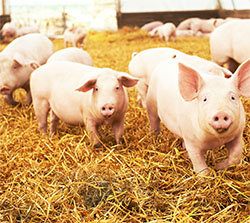 News & Findings
News & Findings
2018 Study Update
- Message from the Executive Committee
- Who is the AHS Research Team
- The Past 25 Years
- Key Findings from the Study
- Looking Towards the Future
Message from the Executive Committee
Dear Agricultural Health Study Participant,
It’s hard to believe that it has been 25 years since we launched the Agricultural Health Study (AHS)! Your participation has led to many discoveries about how pesticide use and other farm activities may impact health. In this issue, we reflect on the past quarter century, highlight key findings and describe future plans—there is so much more to learn about agricultural exposures and health. We appreciate your contribution and dedication, and hope you will continue to participate.
To learn more about AHS activities, please visit our website (https://aghealth.nih.gov) or call us at 1-800-4-AGSTUDY (1-800-424-7883).
Who is the AHS Research Team

The AHS is led by a team of scientists from several government agencies. Over the years, we have worked closely with researchers, practitioners and advisors at several universities, including our partners at the University of Iowa, state departments of public health, and local extension services across the country. We have also collaborated internationally; the AHS serves as a model for the study of the health of agricultural populations around the world.
Everyone on the AHS team is committed to learning how to best protect the health of farmers, their families, and communities. Some of us come from a farming background. Study co-founder Dr. Aaron Blair, study collaborator Dr. Charles Lynch, and current Principal Investigator Dr. Laura Beane Freeman grew up on farms in the Midwest, and Staff Scientist Dr. Christine Parks lives on a family farm in North Carolina. Regardless of our backgrounds, each of us has devoted the majority of our careers to studying and promoting the of health of agricultural workers and their families.
Together, we are making a difference!
The Past 25 Years
We began the AHS with the goal of better understanding how agricultural exposures and lifestyle factors affect the health of farming populations.
Enrollment (1993-1997). A total of 89,655 participants joined the study, including 52,394 licensed private pesticide applicators and 32,345 of their spouses from North Carolina and Iowa, along with 4,916 commercial pesticide applicators in Iowa. Applicators were enrolled at state pesticide licensing and continuing education facilities, and spouses completed an enrollment survey at home.
Facts at enrollment:
- The average age of participants was 45 years (range: 18-93)
- 99% of private applicators were farmers. On average, they had mixed or applied pesticides for 16 years
- 93% of spouses of private applicators were women. While a majority had used some pesticides, many also worked on the farm and 10% reported using three or more agricultural pesticides
- Most commercial applicators were certified in agricultural weed and insect control. On average, they had mixed or applied pesticides for 11 years
Collecting Information. Since enrollment, participants completed three follow-up surveys to update information on farming practices, lifestyle and health. These were done during the years 1999-2003, 2005-2010, and 2012-2015. As part of the first survey, some participants also completed a diet questionnaire and provided a mouth rinse sample containing cheek cells that have been used to study how genes may affect disease risk.
Facts from the third survey (2012-2015):
- The average age of participants was 65 years
- Over 70% lived on a farm
- Two-thirds of private applicators still grew crops or raised livestock, and half had personally mixed or applied pesticides in the past year
Special Studies. Over the years, many participants have taken part in special studies focusing on specific health conditions or exposures. For these special studies, participants may have completed additional questionnaires and special tests, and provided biological samples.

- 1998: A study of farm-related injuries explored risk factors for falls and machine-related injuries in participants from Iowa.
- 2000-2003: Small groups of farmers participated in studies that measured actual exposures to certain pesticides (e.g., 2,4-D and captan) during different stages of farming and pesticide use.
- 2006-2008: The Neurobehavioral Study enrolled about 700 farmers to assess the impact of pesticide use on neurobehavioral function.
- 2007-2009: The Farming and Movement Evaluation (FAME) Study included 115 participants with Parkinson’s disease and 381 participants without the disease to evaluate pesticide use and risk of developing Parkinson’s disease.
- 2009-2013: The Lung Health Study enrolled more than 3,000 participants to examine the impact of farm exposures and genetics on lung function and asthma.
- 2010-2017: The Biomarkers of Exposure and Effect in Agriculture (BEEA) Study enrolled over 1,600 participants to investigate farm exposures and biological changes that may indicate risk for developing certain diseases.
- 2015-2017: The Memory and Aging Study enrolled over 2,600 participants to examine if exposure to pesticides increases the risk of developing memory problems in later life.
Key Findings from the Study
The information you provided has allowed us to study a range of topics relevant to the health and safety of farmers, their families, and their communities. Below we recap some findings from the past 25 years. To learn more about our findings, please see the News & Findings page.
1995-1999
- Participants who mixed pesticides, repaired pesticide equipment regularly, or frequently used insecticides were more likely to seek health care related to pesticide use.
- Besides applying pesticides, participants could be exposed to pesticides through living near where pesticides were mixed or stored, and laundering clothing worn during pesticide application.
2000-2004

- One in five farmers reported current wheeze, which was associated with raising animals, driving a diesel tractor, or using certain pesticides.
- Farm-related injuries were reported at higher rates by younger participants, those who worked longer hours, those with hearing loss, or those who raised large livestock.
- Some pesticides were associated with developing prostate cancer among participants with a family history of prostate cancer but not among those with no family history.
- Metolachlor, pendimethalin, chlorpyrifos and diazinon were associated with developing lung cancer.
2005-2009
- Parkinson’s disease was more common in participants with more lifetime days of pesticide use or who reported a “high pesticide exposure” event.
- Women who grew up on a farm reported allergic asthma as adults less often than women who did not grow up on a farm.
- Diabetes in farmers was more common in those with greater use of organochlorine insecticides, while diabetes during pregnancy was more common in women with pesticide exposures during early pregnancy.
- AHS participants were more likely than individuals in the general population to have MGUS (monoclonal gammopathy of undetermined significance), which is a precursor to multiple myeloma, a rare cancer of the bone marrow.
2010-2014
- Participants had lower rates of cancer overall compared to individuals in the general population in Iowa and North Carolina. Some specific cancers, however, were more common in participants, such as lip, thyroid, prostate, and multiple myeloma.
- Death rates for most causes were lower in the AHS than in the general population, but deaths from unintentional injuries were more common.
- Atrazine use was not associated with overall cancer. A suggested association with thyroid cancer was found for participants with higher atrazine use, but this association needs confirmation.
- Farmers who wore chemically-resistant gloves when mixing and applying 2,4-D had 70% less pesticide in their urine than those not wearing gloves. Orchard farmers wearing gloves when applying captan had 80% less pesticide on their hands.
- An aggressive form of prostate cancer was associated with greater use of malathion and terbufos by farmers.
- DDT, lindane, permethrin, diazinon and terbufos were associated with some forms of non- Hodgkin lymphoma.
2015 - Present
- Age-related macular degeneration was associated with using chlordane, DDT, malathion and captan.
- Daily use of diesel tractors was associated with increased rates of lung cancer.
- Protective glove use and hygiene practices were associated with a reduced rate of Parkinson’s Disease among farmers using paraquat, permethrin, and trifluralin.
- Alachlor use was associated with higher rates of laryngeal cancer.
- Glyphosate use was not associated with overall cancer risk.
Looking Toward the Future

We have much more work to do to understand how farm exposures may affect health. Later this year, we will ask you to once again update your health information. With this follow-up information, we can learn more about diseases that may take decades to develop. Even if you are no longer farming, your input matters!

AHS participants have told us that the health of their family is most important to them. Soon we will begin inviting adult children of AHS participants to enroll in a new study called the Early Life Exposures in Agriculture Study (ELEA). This study focuses on how growing up on a farm impacts health in early adulthood and beyond.
As we look to the future, we thank you for your participation and the significant contributions you have made to identify factors that promote good health in farming communities.

